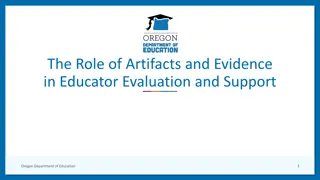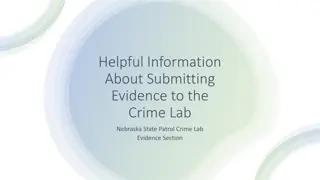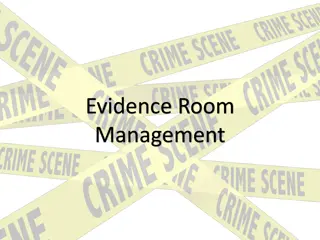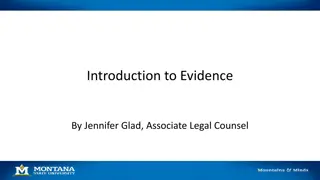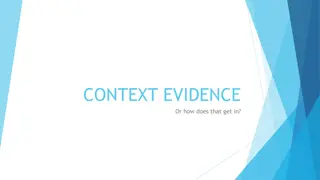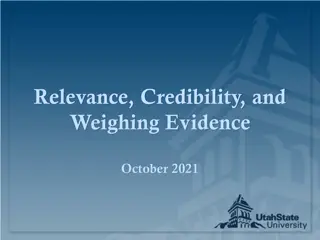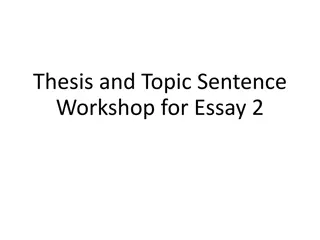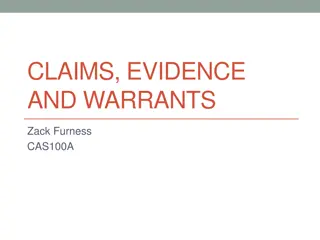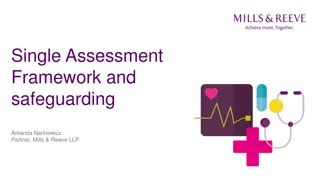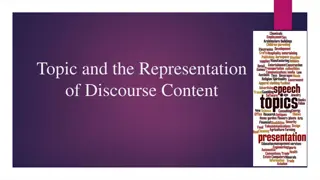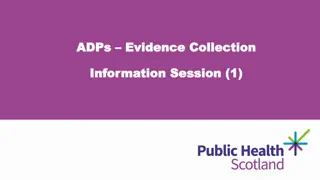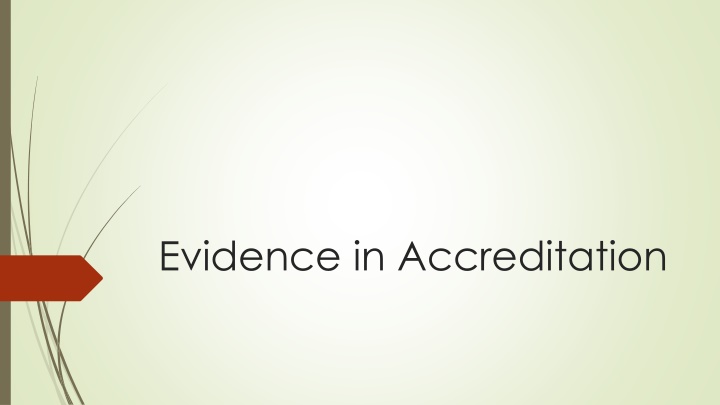
Importance of Evidence in Accreditation: Collecting and Utilizing Data Effectively
Understand the critical role of evidence in accreditation processes, including how it is collected, reviewed, and utilized to support institutional claims and drive continuous improvement. Explore various sources and types of evidence that demonstrate meeting standards and commitment to equity.
Download Presentation

Please find below an Image/Link to download the presentation.
The content on the website is provided AS IS for your information and personal use only. It may not be sold, licensed, or shared on other websites without obtaining consent from the author. If you encounter any issues during the download, it is possible that the publisher has removed the file from their server.
You are allowed to download the files provided on this website for personal or commercial use, subject to the condition that they are used lawfully. All files are the property of their respective owners.
The content on the website is provided AS IS for your information and personal use only. It may not be sold, licensed, or shared on other websites without obtaining consent from the author.
E N D
Presentation Transcript
The Importance of Evidence Evidence will be reviewed by team of peer evaluators Evidence supports the institutions claim that it meets or exceeds a standard Evidence can be presented in a variety of formats (tables, charts, graphs, samples of student work, SLO assessment results etc.) Evidence consists of various data that has been collected and analyzed during the preceding 6 years preceding the self evaluation year. Evidence must clearly demonstrate that a Standard is being met. The Evaluation teams and the Commission carefully review the evidence and will base their conclusions on their findings as supported by the evidence presented.
The Importance of Evidence Accurate and Up-to-Date Consistently used in the planning and implementation of improvements to the overall institution and its programs and services. From reliable Sources Longitudinal and Disaggregated by subpopulations of students as deemed appropriate Shared and Discussed among relevant parties within the institution so that all directly responsible for student progress toward attaining student learning outcomes and achieving educational goals may use the evidence to plan and implement any needed improvements.
Where can evidence be collected? 1. Program Review 5. Budget Committee 9. Student Focus Groups 2. Institutional Effectiveness 6. Guided Pathways Committees 10. CE Committees 3. Planning Councils 7. Equity Plans 4. Academic Senate Minutes 8. Event Flyers
Other possible sources of Evidence Institutional databases and fact books Catalogs Planning documents and program reviews Faculty/student handbooks Policy statements Minutes of important meetings Course outlines and syllabi Survey results Faculty grading rubrics and assessment of SLO s Special research projects and reports
What type of evidence can be gathered from Guided Pathways/Redesign work ? 1. Initial Guided Pathways Plan (approved by Senate) 2. Scale of Adoption Assessment (approved by Senate) 3. Mapping day documentation 4. Sorting day documentation 5. Area of Interest or Metamajor organization 6. Enrollment management committee work 7. Institutional Effectiveness Goal Setting 8. Curriculum Development (minutes of Curriculum Committee) 9. Professional Development Activities 10. Student Focus Groups 11. Action and Implementation Plans 12. Program Review Documents
What evidence can be used to demonstrate your college s commitment to equity?: College Equity Plan Disaggregated Student Success/Completion/Retention Data Action plans that demonstrate the practice of equity at the District Planning level College Mission, and College Strategic Goals and Objectives Professional Development Opportunities for Faculty and Staff Equitable Hiring Processes and revised EEO Plans Senate/Guided Pathways/District Committees that focus on the practice of equity Curriculum development and revision that is grounded in the practice of equity Opportunities for student agency, participation, and learning through the planning process development of Guided Pathways Reassessment of Program Review to incorporate measurement of new plans and structures Commitment to Equitable onboarding processes SEA Plans and Budgets
How much is too much or too little evidence? 1. Balance between data and narrative 2. Let the evidence drive the narrative 3. Qualitative and Quantitative Evidence 4. Evidence demonstrating the collaborative process of shared governance
Other possible sources of evidence can be found in the ACCJC resource Guide to Institutional Self-Evaluation, Improvement, and Peer Review (ed. 2020). Guide to Understanding and applying standards can be found on page 33 Possible sources of evidence follow each standard These lists are non-exhaustive Lists are not intended to indicate documents that must be referenced, only possibilities Examples are meant to guide toward evidentiary documents that the institution actually has Evidence will be relevant to the institutions unique mission, culture, and methods of operation
Standard I:1 Mission, Academic Quality2 and Institutional Effectiveness, and Integrity The institution demonstrates strong commitment to a mission that emphasizes student learning and student achievement. Using analysis of quantitative and qualitative data, the institution continuously and systematically evaluates, plans, implements, and improves the quality of its educational programs and services. The institution demonstrates integrity in all policies, actions, and communication. The administration, faculty, staff, and governing board members act honestly, ethically, and fairly in the performance of their duties. A. Mission 1. The mission describes the institution s broad educational purposes, its intended student population, the types of degrees and other credentials it offers, and its commitment to student learning3 and student achievement.4 (ER 6)5 POSSIBLE SOURCES OF EVIDENCE*: - Board policy that states the mission; - Web page, catalog page, CEO s message, or white paper that explicates the mission; - And/or other documents that demonstrate the institution is aligned with this Standard. REVIEW CRITERIA: The institution s mission addresses the institution s educational purpose. The mission defines the student population the institution serves.
When presenting evidence in the ISER, the institution does not need to present every available evidence document imaginable. Institutions should not overwhelm the peer review team with the greatest amount of evidence possible. The goal is to provide the most relevant evidence that will substantiate the institution s claim that it meets Standards. The institution should aim for quality, not quantity. (Guide to understanding and Applying Standards, page 34)

